By healthiergang writer Valentina Ottaviani, fitness instructor and sports, wellness and fashion journalist.
Pilates Exercises
Joseph H. Pilates once said: "After ten sessions you will feel the difference, after twenty this difference will be visible, after thirty your body will be completely changed".
The Pilates method, introduced by the homonymous founder, has become an essential point of reference for conscious movement, which aims to develop muscle and postural control, as well as flexibility, elasticity, agility, muscular endurance and power.
The basic principles of Pilates are the link of the whole network of new responsible movement trends, which appear on the market and as confirmed by the majority of people who practice it, it is seen as one of the main health therapies, of strength and beauty used regularly for their psychophysical well-being.
Having in itself principles of stretching, muscle toning, mental concentration and physical balance, we can consider Pilates a real trait d'union between the ancient principles of oriental disciplines, such as balance, center of gravity, concentration, breath and movement control, and modern principles of muscle training such as stretching, posture, work for kinetic chains.
Excellent base of movement, this primarily guarantees good posture as an indispensable basis of joint health.
The Pilates method is in practice an exercise program, which focuses on postural muscles, i.e. those muscles that help keep the body balanced and are essential to provide support to the spine.
The exercises are fortunate to be able to easily adapt to the abilities and physical limitations of everyone.
Especially in case of muscular problems or back pain it is important to practice the discipline under the guidance of an expert instructor who will be able to show us the best exercises to follow.
Basic Exercises
Let's look at some now basic pilates exercises and their execution:
#1 The Hundred
It is a warm-up exercise that promotes coordination between movement and breathing as the latter stimulates circulation and resistance by strengthening the abdominals and the muscles of the lower limbs, thus also increasing the stability of the center of gravity.
The Hundred is an exercise preparatory to all supine exercises. You lie on your back with your legs extended and your arms at your sides with the palm facing the ground. From this position the head is raised and the chin touches the rib cage, while the legs, which are also raised, can be either extended to 45 ° or folded at the table.
Raise and lower the upper limbs keeping them taut without touching the ground. Perform a quick "floating" movement (maximum height 25 cm) with your arms only, while trunk and legs remain motionless.
Breathe in through your nose for 5 movements and breathe out through your mouth for another 5 movements.
Repeat this sequence for 100 movements (hence the name from which the exercise derives), which are equivalent to 10 full breaths. The exercise ends by returning to the starting position with arms and legs on the ground.
The muscles that are involved in this exercise are really many such as the rectus abdominis, the transverse abdominis, pelvic floor, oblique muscles, iliac flexors, scapular stabilizers, adductors and quadriceps in isometry, neck flexors and arm muscles.
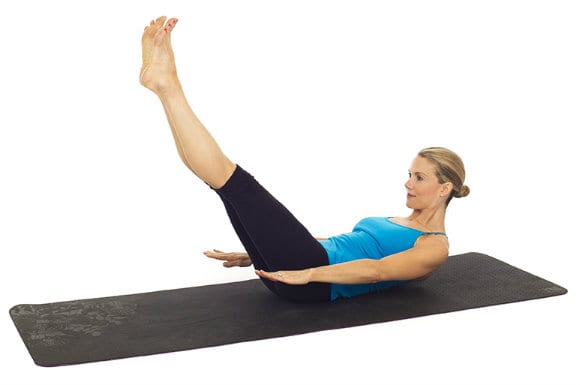
#2 Roll Up
Sdraiati supini, le legs are extended and joined with hammer feet, the arms are stretched back over the head with the palms facing up.
Slowly bring your arms, during the inhalation phase, forward at eye level perpendicular to the body. The chin approaches the chest and lifts the torso off the mat by contracting the abdomen reaching the sitting position.
From here you continue to descend forward with your arms outstretched until you reach the feet. The head touches the legs and the hands go beyond the feet. From this position you return to the starting position by slowly unrolling your back, which, maintaining a C-shaped posture, returns to rest on the ground. Repeat the exercise 5 times.
I benefits of exercise: we work on the strength of the abdominal muscles and the center of gravity (power house) and on the joints of the spine. It stretches and strengthens the spine, stretches the tendons, develops the strength of the center of gravity and decompresses the lower back.
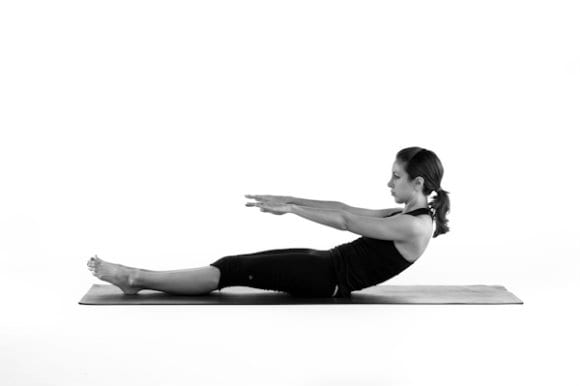
#3 One Leg Circle
After performing the Roll Up, I maintain a supine lying position and bring my arms to my sides.
I lift my straight leg up and inhale while the other is lying on the ground. The raised leg draws five circles clockwise in the air (from the inside to the outside) then with a scissor cut I change leg and draw 5 circles with the other leg.
Run 5 reps clockwise and counterclockwise per leg. When performing the exercise it is important to keep the pelvis anchored to the ground without unbalancing and without compressing the neck.
The main muscles involved are the abdomen, quadriceps and iliopsoas.
Exercise allows the pelvis stabilization and hip mobilization. It stretches and tones the inner and outer thighs and the leg is used as a brush to draw circles in the air.
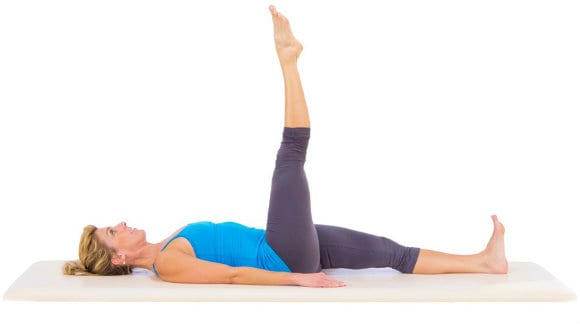
#4 Single Leg Stretch
Lie on your back your arms are along your body. He lifts his head and shoulders off the mat. From this position the right knee is brought to the chest and the other leg is lifted off the floor at 45 ° while remaining extended.
The right hand holds the right ankle and the left holds the right knee. From this position, the legs are exchanged (the right goes down and the left rises to the chest, always keeping the abdomen contracted), inhaling for two movements and exhaling for another two. The chin rests on the chest, the elbows are open and the buttocks and abdomen contract.
The muscles involved in the exercise are the abdominals, quadriceps, iliopsoas and neck flexors.
This is an excellent exercise for the whole abdominal area, also perfect for improving the coordination of movements in which the trunk is held still. It stretches and strengthens the legs and lower back, strengthens the abdominal wall and increases coordination and joint mobility of the hips and knees.
#5 Rolling like a ball
During this exercise it involves rolling onto your back with a movement similar to that of a ball.
You start sitting on the mat with your knees bent and your head tilted towards your knees. The hands grab the shins and the elbows are wide. Tilt your head slightly forward and let yourself go backwards until you touch the mat up to shoulder height and return to the starting position.
The exercise therefore involves "rocking on the back" to perform a massage on it. Breathe in during the first phase of movement, exhale to return to the starting position. Repeat the exercise 6-10 times.
It is important to NEVER roll on the neck, the head must never touch the mat and the back must maintain the C-curve. The muscles mainly involved are the abdominals and this exercise offers a pleasant self-massage of the back.
Among the many other exercises of the pilates beginner level we find:
- Roll over
- Double leg stretch
- Double Straight leg stretch
- Criss-Cross
- Spine Stretch
- The Saw
- The Seal
Intermediate Exercises
After gaining knowledge of your body and fluency in movements with the basic exercises, let's take a look at those intermediate.
#1 The Rocker Open Legs
Sitting balanced on the coccyx, the legs are extended, the arms along the legs and the hands keep the knee inside.
From here inhale and bend your knees while grabbing your ankles remaining in balance with the contracted abdomen. Now bring your legs apart over your head while keeping your hands on your ankles and letting your toes touch the mat.
This exercise tests balance, flexibility, strength and concentration to maintain the position while rocking.
#2 The Cork-screw
Exercise you start lying on your back with your arms at your sides and the toes in downward extension. Breathe in and lift the legs together almost like a candle with the arms that remain extended on the ground next to the torso while the body rests on the shoulders and head.
From this position I make my straight legs go down slightly, without touching the mat, and I bring them to the right making the torso do a kind of twist always to the right. Now I make my legs circle in the position I am in from right to left. I do the same thing on the other side as well.
This exercise must be performed keeping the upper body on the mat while swinging your legs up and focusing your attention on your abs. You start with small circles as they gradually increase in size.
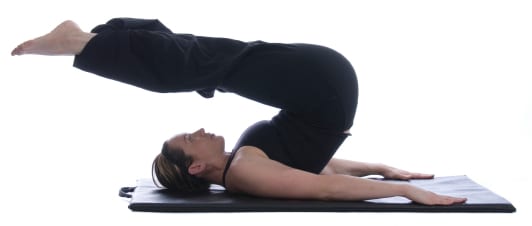
#3 The Neck Pull
Lying on your back on the mat, your hands are crossed behind your neck, your elbows are open and resting on the ground. The legs are stretched forward, hammer feet. The chin rests on the chest, the abdomen is contracted.
From this position the back rises from the ground maintaining a C-curve. With the help of breathing I continue to bend the trunk forward until the head touches the knees. The elbows are always open. Slowly with the breathing I return to the starting point and repeat the exercise 5-6 times.
Benefits of this exercise are the stretching of the muscles of the upper back and the back of the legs thanks to the straightening of the spine. It also allows you to work on the abdominals in a contracted and elongated position.
#4 The Teaser
Sitting on the mat resting on the ischium, the back is straight, the neck stretched upwards and the arms are straight at the sides. Legs together and extended forward. Bend the chin towards the chest, push the abdomen in. Rock your back backwards until the legs are raised up square.
The arms are stretched forward parallel to the legs. Contract your abs to hold the position.
This exercise blends strength, power, flexibility and control together. It is also an exercise that requires some experience in practicing it.
Advanced Exercises
After practicing and developing some body flexibility as well as having laid the foundation of the discipline on your body we can move on to advanced level with some exercise.
#1 The Scissor
We are lying on our backs on the ground, our arms are long hips and legs straight extended forward with your toes pulled.
Inhaling we bring the legs up almost in the position of the candle. The body rests on the head, shoulders, back, neck and elbows, which support the pelvis with the hands. Always helping you with your breathing, I open my legs keeping them taut one after the other with a scissor kick. Alternate the scissoring while keeping the pelvis up with the help of your hands.
This exercise is very challenging as it shifts the center of gravity. The trunk remains motionless while the legs are balanced and move freely. The purpose of the exercise is to open the front of the hips.
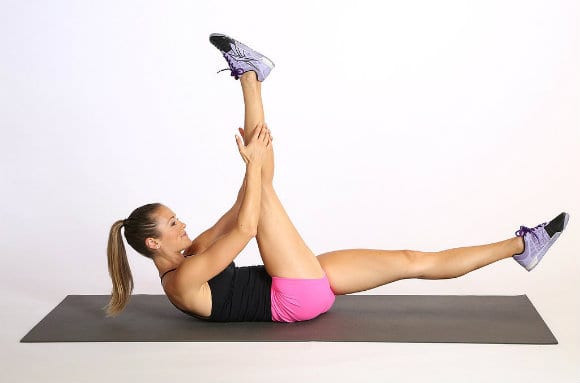
#2 The Bicycle
This exercise looks a lot like the previous The Scissor both for the starting position and in the evolution only that instead of the scissor kick we perform the slow movement of the bicycle with the legs, keeping the back firmly and the abdomen contracted.
While one leg is extended the other bends. Pedal slowly, expanding the movement.
#3 The Hip Circle
This is one of the most difficult exercises of the advanced protocol. Seated on a mat resting on the ischium, the spine and neck are stretched upwards while the legs are extended on the ground. The arms are extended behind the pelvis a bit far away and the hands rest on the ground with the fingers pointing outwards.
Now contract your abdomen and raise your legs in front of you to square while keeping your back fairly straight. By applying strength to the abdomen and arms, which remain firmly on the ground behind the pelvis, I move my legs to the right and left, drawing a sort of semicircle in front of the torso. Help in movement with breathing.
The benefits of this exercise, albeit complicated, are found on the abdominal wall, which keeps the trunk stable while drawing a circle with the legs.
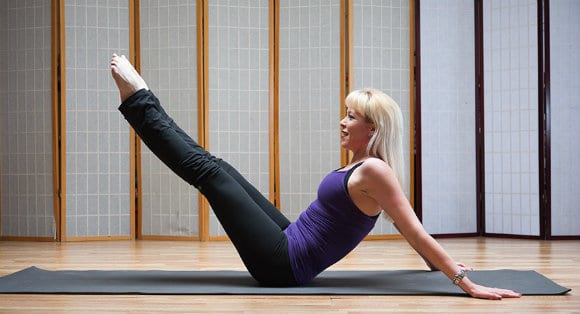
#4 Shoulder Bridge
Another advanced level exercise that we can do is the so-called "bridge". The starting position foresees the subject lying on the mat with the lower limbs in flexion and bent according to the width of the pelvis. The arms are extended at the sides.
From here, inhale and exhale and lift your pelvis off the mat and rest on your shoulders. With the pelvis raised, contract the abdomen and inhale from there extend one leg towards the ceiling while the other remains bent on the ground with the foot in plantar flexion. Exhaling, the leg goes down until it is parallel to the other knee and then goes back up.
I perform this exercise 3 times per side, then I return to place my foot on the ground and slowly lower my pelvis back on the mat. This exercise involves many muscles such as arms, rectus abdominis, transverse muscle, obliques, extensors and hip flexors. The main purpose of the execution is the strengthening of the buttocks, the stabilization of the pelvis and coordination.


























